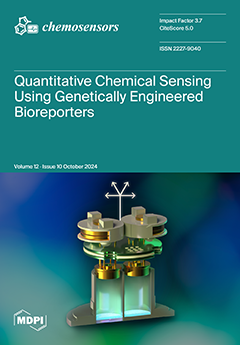Antimony (Sb) is currently a widespread element with key roles in telecommunication, sustainable energy, and military industries, among others. Its significant toxicity determines the need to realize sensors for water, air, and soil and the industrial process monitoring of Sb species. Unfortunately, no
[...] Read more.
Antimony (Sb) is currently a widespread element with key roles in telecommunication, sustainable energy, and military industries, among others. Its significant toxicity determines the need to realize sensors for water, air, and soil and the industrial process monitoring of Sb species. Unfortunately, no antimony sensors exist so far, and just laboratory analysis methods are in use. We aimed to contribute to the development of optical sensors for the metalloid by tailoring, for the first time, luminescent Ru(II) and Re(I) polypyridyl complexes to probe and quantify the presence of Sb(III). The molecular design of the complexes includes the multifunctional Sb-binding 2-(2,2′-bithien-5-yl)-1
H-imidazo[4,5-
f]-1,10-phenanthroline (
btip) ligand that ensures the molecular binding of Sb(III) in organic media. The Ru(II)-
btip complex is additionally endowed with one 2,2′-bipyrazine (bpz) or two 1,4,5,8-tetraazaphenanthrene (tap) ligands, namely [Ru(bpz)(
btip)
2]
2+ and [Ru(tap)
2(
btip)]
2+, that boost the excited state oxidation potential of the probe, leading to an intramolecular photoinduced electron transfer from
btip to the Ru(II) core. The latter is suppressed upon interaction with Sb(III), leading to an 11-fold increase in both the luminescence intensity and lifetime of [Ru(bpz)(
btip)
2]
2+ in the presence of ca. 50 μmol L
−1 of SbCl
3 in organic medium. The fluorescence intensity of [Re(CO)
3(H
2O)(
btip)]
+ also increases upon interaction with Sb(III) but to a much lesser extent due to the intraligand π*→π nature of its emission compared to the Ru(II) ligand-to-metal excited state deactivation. However, the weak π*→d emission band in the red spectral region of the former is quenched by the semimetallic element. The sensing mechanisms of the Ru(II)- and Re(I)-
btip probes that allow luminescence intensity (Ru, Re), ratiometric (Ru), and lifetime measurements (Ru) are compared and discussed in this initial solution sensing study.
Full article





